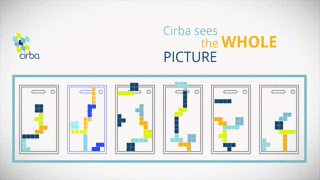“…there are very few movies that wouldn’t benefit from losing twenty minutes and the inclusion of an exploding helicopter shot…”
— Roger Corman
This quote, which I first heard on Mark Kermode’s BBC Film Review podcast, may not appear to have much to do with marketing videos, but I think it reflects an attitude video producers might consider adopting. True, we’re not going to be able to come up with the equivalent of an exploding helicopter, but I’ve seen very few marketing videos that couldn’t be improved with a little more explosive visual stimulation.

We recently produced several videos for use in the noisy VMworld Expo environment. Lots of text on the screen, no voiceover narration. Fortunately, our client, Cirba, uses a relatively stimulating visual metaphor to explain how their analytics solution makes virtual environments more efficient, and we were able to adapt their visual metaphor to good advantage.
As to the benefit of “losing twenty minutes,” the explainer video equivalent is probably losing 20 seconds or more. We registered the 2-Minute Explainer brand in 2004. But we’re making lots more videos these days that clock in at 90 seconds or less.
Don’t tell people what they already know
The first rule of short videos is “Don’t tell people stuff they already know.” The best way to figure out what your prospects already know is probably to ask the sales team.
It would be an interesting exercise to recast a proposed script outline as a survey for the sales force. That is, say you plan to start out your video with a statement like “The amount of information in today’s IT environment is rapidly increasing.” Many explainer videos start like this.
But suppose you had canvassed the sales team as follows:
On a scale of 0-5 (0 = clueless), how likely is it that potential buyers of our solution are aware that the amount of information in today’s IT environment is rapidly increasing?
Don’t you think the response might prompt you to try a different approach?
Don’t talk to different audiences
We’re developing some videos in the data security space and have been looking at videos from a number of different solution providers. One video we reviewed devotes the first 60 seconds (out of just over two minutes) to establishing that data security is essential to protect brands and avoid compliance problems, and that security solutions are often complex. In the next 60 seconds, it asserts that the solution is to implement an easy-to-manage combination of stateless tokenization, format-preserving encryption, and stateless key management, without defining any of these. Now, is it likely that anyone who knows what stateless key management is, is unaware that data security should be taken seriously and can be complex? Contrariwise, if you don’t take data security seriously, would you know (or care) about stateless key management? Or would it sound like something from a buzzword generator?
Don’t say what your solution is not
For one thing, visually depicting what something is not is difficult and potentially confusing. You may need to overcome misconceptions or misinformation, but there is usually a positive way to do it — an appropriate use case, for example.
Skip the recap
You might also consider not summarizing. Yes, you want to the viewer to take away a message. But you want action, too. In many cases, all you really want to achieve is to get the viewer to seek more information. Shorten the summary and get right to the call-to-action.



